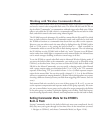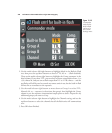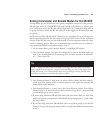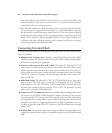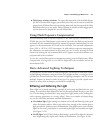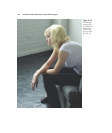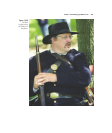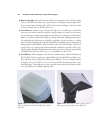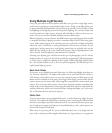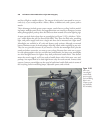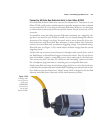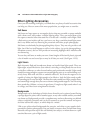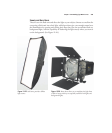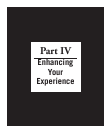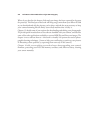Using Multiple Light Sources
Once you gain control over the qualities and effects you get with a single light source,
you’ll want to graduate to using multiple light sources. Using several lights allows you
to shape and mold the illumination of your subjects to provide a variety of effects, from
backlighting to side lighting to more formal portrait lighting. You can start simply with
several incandescent light sources, bounced off umbrellas or reflectors that you con-
struct. Or you can use more flexible multiple electronic flash setups.
Effective lighting is the one element that differentiates great photography from candid
or snapshot shooting. Lighting can make a mundane subject look a little more glam-
orous. Make subjects appear to be soft when you want a soft look, or bright and sparkly
when you want a vivid look, or strong and dramatic if that’s what you desire. As you
might guess, having control over your lighting means that you probably can’t use the
lights that are already in the room. You’ll need separate, discrete lighting fixtures that
can be moved, aimed, brightened, and dimmed on command.
Selecting your lighting gear will depend on the type of photography you do, and the
budget you have to support it. It’s entirely possible for a beginning D7000 photographer
to create a basic, inexpensive lighting system capable of delivering high-quality results
for a few hundred dollars, just as you can spend megabucks ($1,000 and up) for a
sophisticated lighting system.
Basic Flash Setups
If you want to use multiple electronic flash units, the Nikon Speedlights described ear-
lier will serve admirably. The higher-end models can be used with Nikon’s wireless i-
TTL features, which allows you to set up to three separate groups of flash units (several
flashes can be included in each group) and trigger them using a master flash and the
camera. Just set up one master unit, and arrange the compatible slave units around your
subject. You can set the relative power of each unit separately, thereby controlling how
much of the scene’s illumination comes from the main flash, and how much from the
auxiliary flash units, which can be used as fill flash, background lights, or, if you’re care-
ful, to illuminate the hair of portrait subjects.
Studio Flash
If you’re serious about using multiple flash units, a studio flash setup might be more
practical. The traditional studio flash is a multi-part unit, consisting of a flash head that
mounts on your light stand, and is tethered to an AC (or sometimes battery) power sup-
ply. A single power supply can feed two or more flash heads at a time, with separate con-
trol over the output of each head.
When they are operating off AC power, studio flash don’t have to be frugal with the
juice, and are often powerful enough to illuminate very large subjects or to supply lots
Chapter 12 ■ Making Light Work for You 435



